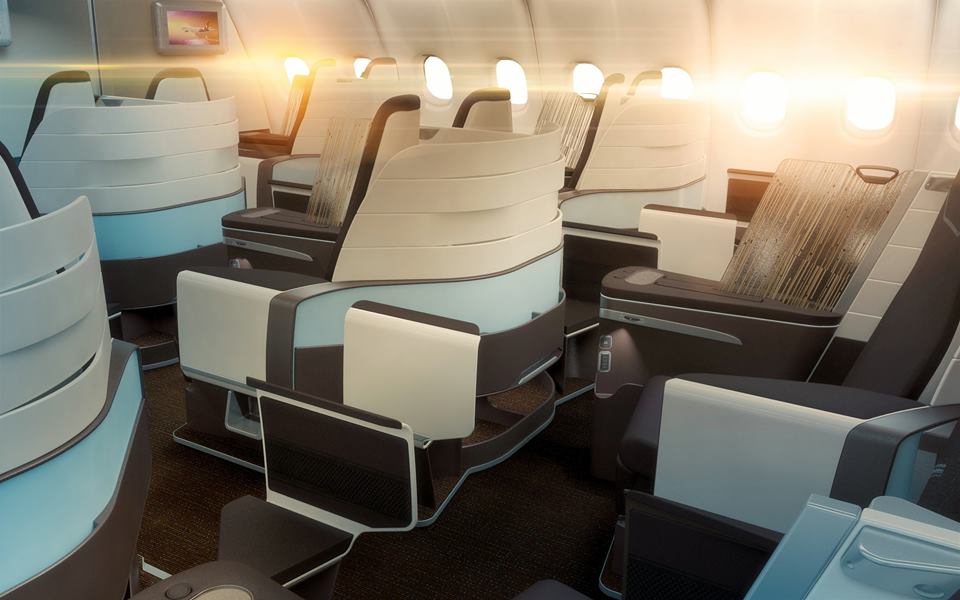Skift Take
Hawaiian Airlines is introducing new business class seats. But if you live in the mainland United States, you may not see a lot of them.
Hawaiian Airlines may be best known for taking West Coast vacationers to the islands, but increasingly, the carrier has global ambitions.
This is part of the reason it is introducing a new business class on its Airbus A330s, with 18 flatbed seats, all 76 inches long. Initially passengers flying between North America and Hawaii should see the new seats, but over time, Hawaiian plans to deploy most aircraft with the cabin on longer flights to places like Tokyo, Sydney, Auckland, Brisbane, Beijing and Seoul.
Hawaiian has already started retrofits, and the cabin will be on all of the airline’s Airbus A330s by the end of next year. Designed by Optimares, an Italian company specializing in traveler-centric design, the seats are a major step up from today’s recliners.
“As our network has evolved over the past four or five years, we have added a lot more of the eight and nine hour international flights,” Peter Ingram, Hawaiian’s chief commercial officer, said in an interview. “The expectation that our guests increasingly have on those routes is different from the expectations of our guests on a flight from the West Coast to Hawaii.”
Hawaiian is unique among U.S. carriers, as it actually sells most of its premium seats, instead of giving them away to frequent fliers. Ingram said Hawaiian generally sells more than 80 percent of seats up front, a number that includes paid, last-minute buy-ups.
Premium demand is strong from most of Hawaiian’s international markets, Ingram said, though the strength of sales often depends on factors outside of the airline’s control. Countries with a robust economies and strong currencies against the U.S. dollar generally account for more business class ticket sales. “There have been times when Australia has just been booming,” he said. Premium demand is also relatively high from larger U.S. cities, such as San Francisco and Los Angeles, and those routes could also see flatbeds over the long term.
The new seats may also help Hawaiian take a greater slice of potentially lucrative one-stop traffic between the Western United States and Australia and New Zealand. For travelers from Sacramento, Las Vegas, Phoenix and Oakland, stopping in Honolulu is just as convenient as the typical stop in San Francisco or Los Angeles. And Hawaiian often charges less for international premium seats than its competitors, which can stimulate demand.
“We do a little bit of that today even without the flatbed product,” Ingram said. “It is based on the geography of where Hawaii is. The nonstop from Sydney to San Francisco would fly right over the top of Hawaii anyway.”
For now, Hawaiian is nearly finished with its current round of international expansion. It soon will increase its flights to Tokyo’s Haneda airport, near downtown, but Ingram said the airline lacks enough long-range aircraft to add much more.
However, more growth is coming. Hawaiian has firm orders for 16 Airbus A321neos, with nine options, all slated for delivery between 2017 and 2020. The single-aisle aircraft will not have the new business class, and most will be deployed between the West Coast and Hawaii, freeing larger planes for longer international routes.
Hawaiian is also planning to add at least six next-generation Airbus A330s in a three-year period starting in 2019. Airbus is predicting the aircraft will have a range of 7,500 miles, putting much of the world in play.
The Daily Newsletter
Our daily coverage of the global travel industry. Written by editors and analysts from across Skift’s brands.
Have a confidential tip for Skift? Get in touch
Tags: business class, hawaiian airlines
Photo credit: Hawaiian Airlines is introducing new business class seats. Paul Wylde Design / Hawaiian Airlines
